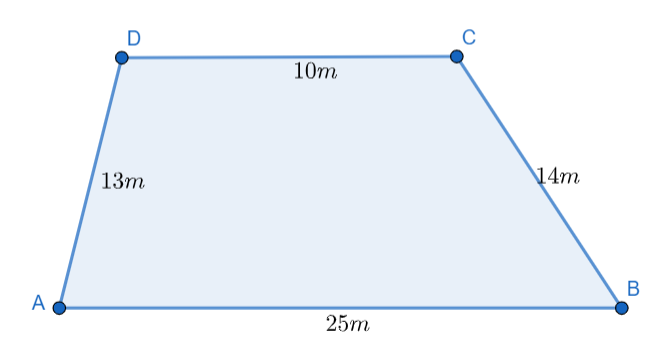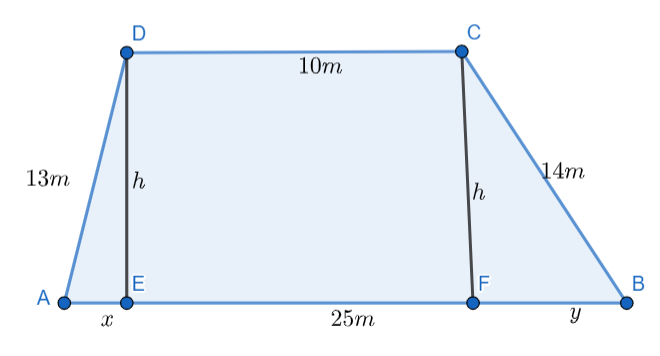
A field is in the shape of a trapezium whose parallel sides are $25\,m$ and $10\,m$. The non-parallel sides are $14\,m$ and $13\,m$. Find the area of the field.
Answer
605.1k+ views
Hint: The given question is related to the area of a trapezium. To find the distance between parallel sides, draw perpendiculars from the vertices to the opposite parallel side and use Pythagoras theorem in the triangles formed.
Complete step-by-step answer:
Consider the trapezium $ABCD$ with $AB\parallel CD$. The lengths of the parallel sides are given as $25\,m$ and $10\,m$. So, $AB=25\,m$ and $CD=10\,m$. The lengths of the non-parallel sides are given as $14\,m$ and $13\,m$. So, $AD=13\,m$ and $BC=14\,m$.

We are asked to find the area of this trapezium. We know, if $a$ and $b$ are the lengths of the parallel sides and $h$ is the distance between the parallel sides of a trapezium, then its area is given as $Area=\dfrac{1}{2}\left( a+b \right)h$. In the given problem, we know the lengths of the parallel sides but we do not know the distance between the parallel sides.
Let’s draw two perpendiculars on the side $AB$, one from the vertex $D$ and the other from the vertex $C$. Let these perpendiculars be $DE$ and $CF$ respectively. We know the distance between the parallel sides is the length of the perpendicular line between them. So, $DE=CF=h$, where $h$ is the distance between the parallel sides of the trapezium.

Let $AE=x\,m$ and $FB=y\,m$. $DE$ and $CF$ are two perpendiculars between two parallel lines. So, they must be parallel to each other. So, the distance between them should be constant. So, $EF=CD=10\,m$. So, $x+y+10=25$.
$\Rightarrow x+y=15.....(i)$
Now, in $\Delta AED$ , $DE\bot AE$. So, $\Delta AED$ is a right-angled triangle. Applying Pythagoras theorem, we get ${{x}^{^{2}}}+{{h}^{2}}={{13}^{2}}$.
$\Rightarrow {{x}^{2}}+{{h}^{2}}=169.....(ii)$
In $\Delta CBF$ , $CF\bot BF$. So, $\Delta CBF$ is a right-angled triangle. Applying the Pythagoras theorem, we get ${{y}^{2}}+{{h}^{2}}={{14}^{2}}$.
$\Rightarrow {{y}^{2}}+{{h}^{2}}=196.....(iii)$
Now, from equation $(i)$, we have $x+y=15$. $\Rightarrow x=15-y$
Substituting $x=15-y$ in equation $(ii)$, we get ${{\left( 15-y \right)}^{2}}+{{h}^{2}}=169$.
$\Rightarrow 225+{{y}^{2}}-30y+{{h}^{2}}=169$
$\Rightarrow {{y}^{2}}-30y+{{h}^{2}}=169-225$
$\Rightarrow {{y}^{2}}-30y+{{h}^{2}}=-56$
$\Rightarrow {{h}^{2}}=30y-{{y}^{2}}-56$
Substituting ${{h}^{2}}=30y-{{y}^{2}}-56$ in equation $(iii)$, we get ${{y}^{2}}+30y-{{y}^{2}}-56=196$
$\Rightarrow 30y=252$
$\Rightarrow y=8.4$
Now, substituting $y=8.4$ in ${{h}^{2}}=30y-{{y}^{2}}-56$, we get ${{h}^{2}}=30\left( 8.4 \right)-{{\left( 8.4 \right)}^{2}}-56$.
$\Rightarrow {{h}^{2}}=252-70.56-56$
$\Rightarrow {{h}^{2}}=125.44$
$\Rightarrow h=11.2$
So, the distance between the parallel sides is $11.2\,m$.
Now, we have the values of the lengths of parallel sides as well as the distance between the parallel sides.
So, the area of the trapezium is given as $Area=\dfrac{1}{2}\left( 10+25 \right)\times 11.2=196\,{{m}^{2}}$ .
So, the area of the field is $196\,{{m}^{2}}$.
Note: While making substitutions, make sure that the substitutions are done correctly and no sign mistakes are present. Sign mistakes can cause the final answer to be wrong.
Complete step-by-step answer:
Consider the trapezium $ABCD$ with $AB\parallel CD$. The lengths of the parallel sides are given as $25\,m$ and $10\,m$. So, $AB=25\,m$ and $CD=10\,m$. The lengths of the non-parallel sides are given as $14\,m$ and $13\,m$. So, $AD=13\,m$ and $BC=14\,m$.

We are asked to find the area of this trapezium. We know, if $a$ and $b$ are the lengths of the parallel sides and $h$ is the distance between the parallel sides of a trapezium, then its area is given as $Area=\dfrac{1}{2}\left( a+b \right)h$. In the given problem, we know the lengths of the parallel sides but we do not know the distance between the parallel sides.
Let’s draw two perpendiculars on the side $AB$, one from the vertex $D$ and the other from the vertex $C$. Let these perpendiculars be $DE$ and $CF$ respectively. We know the distance between the parallel sides is the length of the perpendicular line between them. So, $DE=CF=h$, where $h$ is the distance between the parallel sides of the trapezium.

Let $AE=x\,m$ and $FB=y\,m$. $DE$ and $CF$ are two perpendiculars between two parallel lines. So, they must be parallel to each other. So, the distance between them should be constant. So, $EF=CD=10\,m$. So, $x+y+10=25$.
$\Rightarrow x+y=15.....(i)$
Now, in $\Delta AED$ , $DE\bot AE$. So, $\Delta AED$ is a right-angled triangle. Applying Pythagoras theorem, we get ${{x}^{^{2}}}+{{h}^{2}}={{13}^{2}}$.
$\Rightarrow {{x}^{2}}+{{h}^{2}}=169.....(ii)$
In $\Delta CBF$ , $CF\bot BF$. So, $\Delta CBF$ is a right-angled triangle. Applying the Pythagoras theorem, we get ${{y}^{2}}+{{h}^{2}}={{14}^{2}}$.
$\Rightarrow {{y}^{2}}+{{h}^{2}}=196.....(iii)$
Now, from equation $(i)$, we have $x+y=15$. $\Rightarrow x=15-y$
Substituting $x=15-y$ in equation $(ii)$, we get ${{\left( 15-y \right)}^{2}}+{{h}^{2}}=169$.
$\Rightarrow 225+{{y}^{2}}-30y+{{h}^{2}}=169$
$\Rightarrow {{y}^{2}}-30y+{{h}^{2}}=169-225$
$\Rightarrow {{y}^{2}}-30y+{{h}^{2}}=-56$
$\Rightarrow {{h}^{2}}=30y-{{y}^{2}}-56$
Substituting ${{h}^{2}}=30y-{{y}^{2}}-56$ in equation $(iii)$, we get ${{y}^{2}}+30y-{{y}^{2}}-56=196$
$\Rightarrow 30y=252$
$\Rightarrow y=8.4$
Now, substituting $y=8.4$ in ${{h}^{2}}=30y-{{y}^{2}}-56$, we get ${{h}^{2}}=30\left( 8.4 \right)-{{\left( 8.4 \right)}^{2}}-56$.
$\Rightarrow {{h}^{2}}=252-70.56-56$
$\Rightarrow {{h}^{2}}=125.44$
$\Rightarrow h=11.2$
So, the distance between the parallel sides is $11.2\,m$.
Now, we have the values of the lengths of parallel sides as well as the distance between the parallel sides.
So, the area of the trapezium is given as $Area=\dfrac{1}{2}\left( 10+25 \right)\times 11.2=196\,{{m}^{2}}$ .
So, the area of the field is $196\,{{m}^{2}}$.
Note: While making substitutions, make sure that the substitutions are done correctly and no sign mistakes are present. Sign mistakes can cause the final answer to be wrong.
Recently Updated Pages
Master Class 9 General Knowledge: Engaging Questions & Answers for Success

Master Class 9 English: Engaging Questions & Answers for Success

Master Class 9 Science: Engaging Questions & Answers for Success

Class 9 Question and Answer - Your Ultimate Solutions Guide

Master Class 8 Maths: Engaging Questions & Answers for Success

Class 8 Question and Answer - Your Ultimate Solutions Guide

Trending doubts
Which places in India experience sunrise first and class 9 social science CBSE

Fill the blanks with the suitable prepositions 1 The class 9 english CBSE

Write the 6 fundamental rights of India and explain in detail

Difference Between Plant Cell and Animal Cell

What is pollution? How many types of pollution? Define it

What is the Full Form of ISI and RAW




